 | E-mail to Birds Korea |
 | KWBS |
in the Region
 | The Oriental Bird Club |
 | BirdLife International (Asia) |
February
Cold winters mean both temperatures and birding are similar to January, while increasingly frequent mild winters are marked by brief spells of rain or sleet, often followed by warmer sunshine, with maximum temperatures rising to 15°C or more in the southeast.
Many waterbirds are on the move by mid-month: Tundra Beans, Greater White-fronted and usually Swan Geese can be found at the Han-Imjin. Most Baikal Teal start to move north and by month’s end can become difficult to find in southern locations. Rooks and Daurian Jackdaws begin to move back through the Nakdong valley and near Gunsan. February also sees the start of crane migration, with Hooded and White-napeds moving back into Korea from Japan, augmenting the wintering flocks. Some gull species too are also on the move. The now rare Relict and the rather more widespread Saunders’s Gull usually peak in number at the best tidal-flat sites. At the end of the month the very earliest true spring migrants also start to arrive, including the first Eurasian Hoopoes.
February highlights in recent years have included records of Baer’s Pochard, Steppe Eagle, Least Auklet, Snow Bunting, and Common Redpoll.
Outstanding national rarities in February include the second record of Green-winged Teal in 2008, and the second Arctic Redpoll, on Heuksan Island in 2009. Recent Korean firsts in February include Thick-billed Murre (2006), Himalayan Vulture (2007) and Black-winged Kite (2013).
Seoul, February 23
Early on Sunday I met up with Mr. Chakladar at Amsa, and lined up next to the photog phalanx to get a look at a long-staying European Robin – a truly stunning bird. We then headed to Namhansan, and after a lengthy stakeout we were rewarded with extremely close views of a pair of beautifully camouflaged Hazel Grouse. Also at Namhansan, we saw Eurasian Nuthatch, Brambling, Great Spotted and Japanese Pygmy Woodpecker, Coal and Marsh Tit, and a restless group of Rustic Bunting.
The last spot we visited was the Han River at Oksu, with its massive rafts of ducks. We eventually saw the Baer’s Pochard, as well as a hybrid Baer’s. We also met up with some lovely and brilliant Korean birders there, and it was a real treat to compare notes with such knowledgeable and passionate folks.
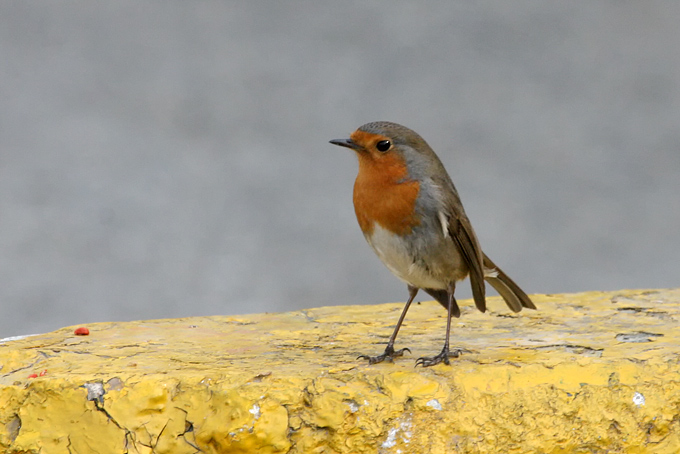
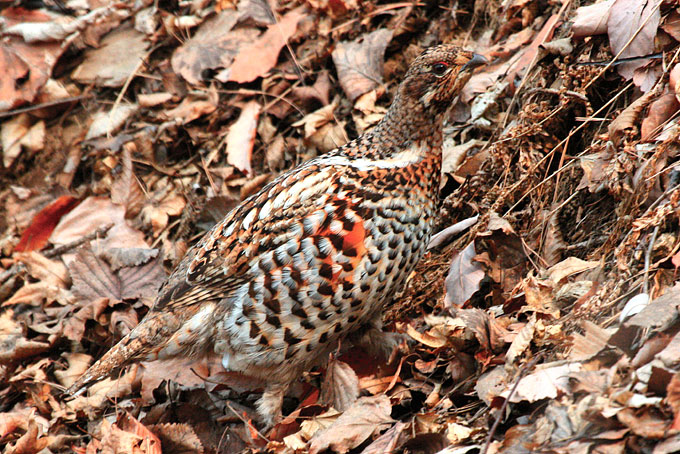
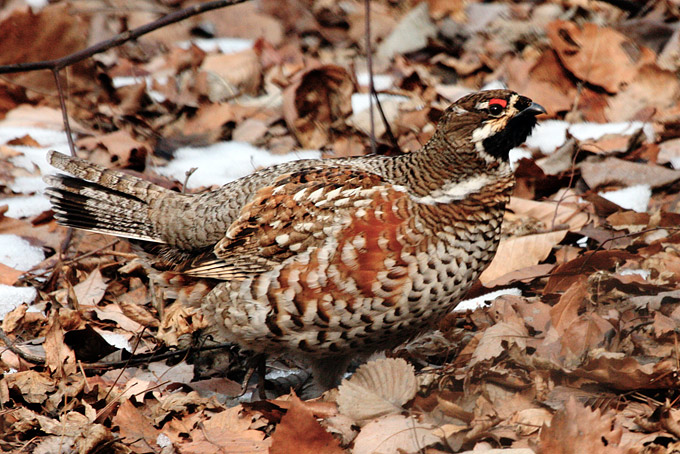
Seoul, February 22
For a ‘non-birding’ trip into Seoul, I managed to get a lot of birding done! On Saturday morning I got great long looks at Gangseo’s resident Plumbeous Water Redstart – an attractive and confiding bird. The rest of the park was buzzing with Naumann’s Thrush, Yellow-throated and Rustic Bunting, as well as Vinous-throated Parrotbill. At the north end of the park, I encountered two Short-eared Owls, and the fifteen or so photographers that follow them around all day. Later in the day at Ilsan Lake Park I spotted a cracking male Long-tailed Rosefinch mixed in with some Yellow-throated Bunting.
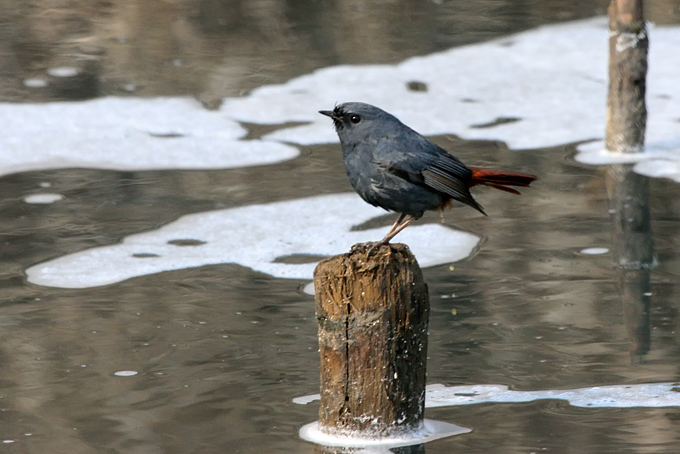
Han River, Seoul, February 22
From the Hannam bridge to the mouth of the Jungnang Stream (a stretch of about 1.7km) there were massed 14800 Common Pochard and 4600 Tufted Duck. Unfortunately they were flushed by an speedboat, although the sound and sight of thousands of wildfowl taking flight was quite something. While counting I also noticed the pure Ferruginous Duck, three Greater Scaup and 32 Smew.
Best for the day of course, good but distant views of the apparently pure drake Baer's Pochard, which displayed to surrounding ducks by suddenly flexing its neck and repeatedly arching it backwards, like a bow being drawn.
Also of interest, three hybrids, including the male Baer's Pochard X Ferruginous Duck and Ferruginous Duck X Common Pochard that I photographed on January 27th. The third, a presumed Common Pochard X Ferruginous Duck, featured a cinnamon-red head and breast, resembling an individual photographed here back in 2008.
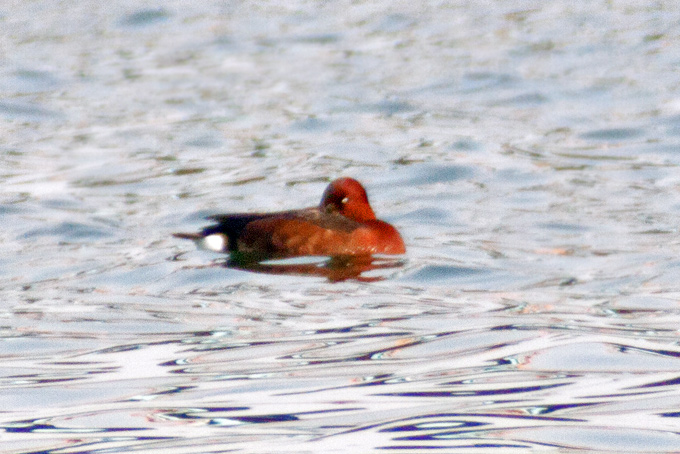
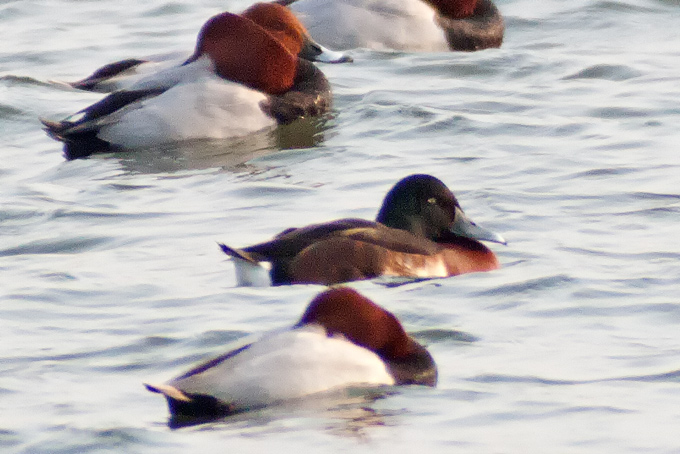
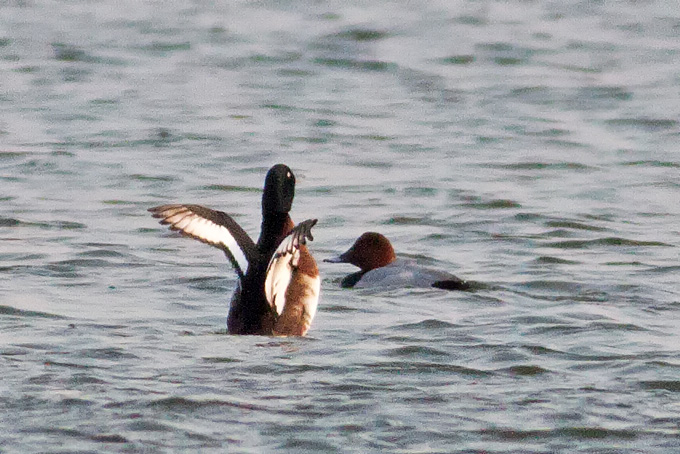
Usop Swamp, February 22
The afternoon visit to the Usop Swamp showed more birds than it was hoped for: a big flock of c. 2000 geese, Taiga Bean and Greater White-fronted, c. 100 Whooper Swan, at least 50 Mallard small groups of Eurasian Teal all around the swamp, several Eurasian Coot, 3 Grey Heron, one Western Great Egret and 3 Eastern Great Egret. Also seen were 5 to 6 Bull-headed Shrike, a flock of Vinous-throated Parrotbill, a flock of Eurasian Tree Sparrow, several Oriental Turtle Dove, an overflying Eastern Buzzard and a Common Kestrel on a nearby pole.
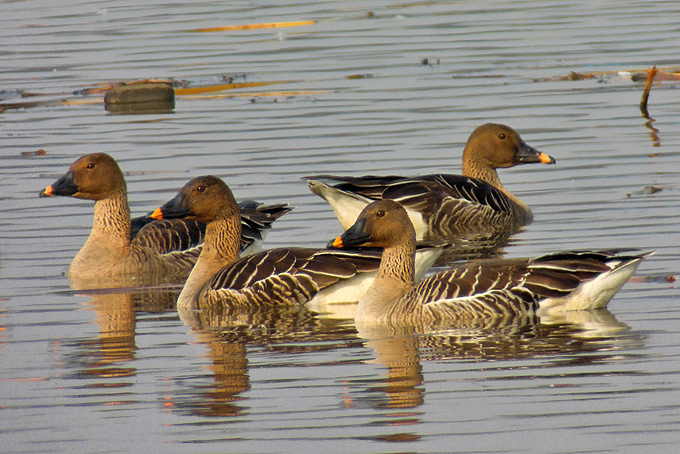
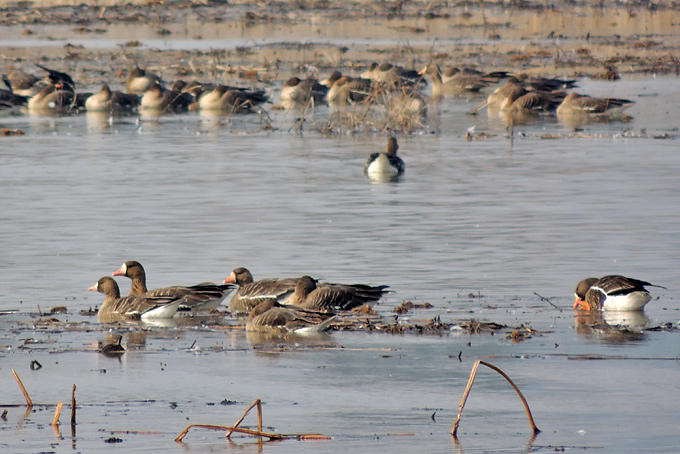



Various Locations, February 15-21
A fairly intensive week of birding around the country (as a prelude to a two-week trip by TS to Japan) produced several outstanding highlights. Out of the 150+ species logged, these included good views of Swan Goose, flocks of Baikal Teal, a single Baer’s Pochard, Scaly-sided Merganser, Solitary Snipe (away from the National Arboretum), Relict Gull, Long-billed Murrelet, Japanese Waxwing, Pallas’s Rosefinch and Ochre-rumped Bunting. On the negative side, it also included observations of oiled birds (most especially Black-tailed Gulls) at several sites along the east and west coasts), probably caused both by chronic oil pollution and recent spills off Busan and Yeosu; sites with restricted access due to Poultry Flu; and yet more construction. Most worrisome, this included a new road being built on the tidal-flat at Yeongjong (near the international airport), the site of the suspended Incheon Tidal Power plants.

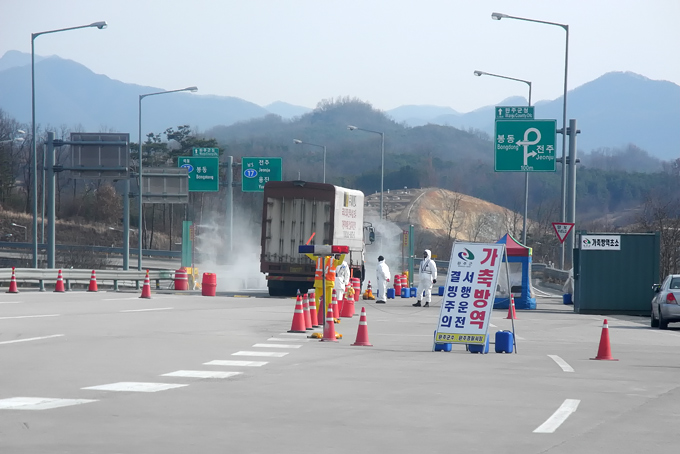
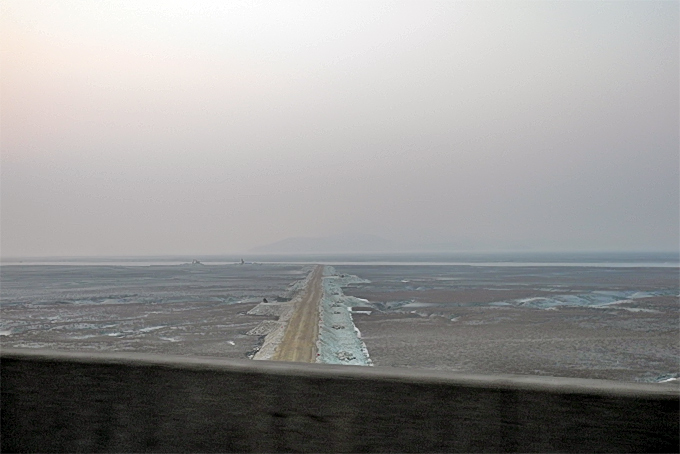
Team Shetland was comprised of Iain Robertson, Richard Schofield, Paul Harvey, Rob Fray (the photographer in the group), Steven Piotrowski and David Okill. Day One (Feb 15th) was spent in Incheon; February 16th, at several sites between Seoul and the East Coast (including the North River); 17th, on the North-east coast (where further heavy snow hampered progress); 18th, on the coast between Uljin and the Guryongpo Peninsula; 19th, at the Nakdong Estuary and then the Geum Estuary; 20th, at Gomso Bay, the Geum Estuary and then Hwaseong; and Day Seven, February 21st, at Hwaseong and in Seoul.
Outstanding highlights (with better images expected to be posted later) included:
- Swan Goose Anser cygnoides. Eighteen at their usual site in the Geum Estuary, watched in perfect light on the 19th.
- Lesser White-fronted Goose Anser erythropus. One adult at the still-closed Junam Reservoirs on 19th (PH only).
- Ruddy Shelduck Tadorna ferruginea. A flock of 290 at Hwaseong on the 21st is a fairly high count for recent years.
- Baikal Teal Anas formosa. One male on the Geum River during the morning of the 20th, was followed by the discovery of a flock of 32,500 on Namyang Lake the same afternoon, with a further ~10,000 or so seen at dusk over Hwaseong the same evening. One was also on Jungnang Stream in Seoul on the 21st.
- Baer’s Pochard Aythya baeri. An adult male, originally found by members of the University Birdwatching Society in late January, and re-found last week, was watched well on the Han River at reasonably close range in good light conditions on the 21st. Although the plumage seemed asymmetrical (with apparently more obvious and extensive white on the left flank than on the right) the bird otherwise looked structurally and plumage-wise spot-on for Baer’s (having an overly large, blue-grey toned bill; a Mallard-green head unsullied with any brown tones; and obvious tiger-striping across part of the otherwise white fore-flanks). The bird was in among a mixed flock of c.4500 aythya, comprised mostly of Tufted Duck and Common Pochard but which also included at least two Greater Scaup. One bird in the same flock that was seen only very briefly was considered by the only observer to see it (PH) to show several characters suggesting male Lesser Scaup.
- Scaly-sided Merganser Mergus squamatus. Eight were on the North River on the 16th, at a site discovered during last month’s survey.
- Oriental Stork Ciconia boyciana. One was seen very briefly at Hwaseong by NM and RF on the 20th, but could not be re-located despite much searching.
- Golden Eagle Aquila chrysaetos. One sub-adult was again present in Odae San National Park on the 16th.
- Steller’s Sea Eagle Haliaeetus pelagicus. One First-winter was at the Nakdong estuary on the 19th.
- Falco sp. A large falcon (perhaps an escaped hybrid?) was at Hwaseong on the 21st. Seen only by NM, it appeared as large or perhaps even larger than female Peregrine, with a more steady flight (originally flying close by low to the ground, it then gained height rapidly and apparently effortlessly through constant wing-beats). Blue-grey above (similar to Northern Goshawk or a paleish adult Peregrine), it lacked either a clean face pattern (being dark-headed without any paler supercilium or “moustache”) or any obvious tail bands, instead showing obvious silvery flashes on the inner primaries of the underwing.
- White-naped Crane Grus vipio. Two at Gomso Bay (perhaps early migrants?) on the 20th were watched well in excellent light (and were considered by some to be most beautiful bird of the trip).
- Pied Avocet Recurvirostra avosetta. Two were with the curlew flock at Hwaseong on the 21st.
- Solitary Snipe Gallinago solitaria. One at Odae San on the 16th, found by PH and seen well by everybody, is an excellent record away from the National Arboretum.
- Eurasian Curlew Numenius arquata. Approximately 3,500 were on the reclamation lake at Hwaseong on the 21st.
- Far Eastern Curlew Numenius madagascariensis. One was seen well at the Geum Estuary on the 19th (indicating overwintering at this site, as two were present there in late December) and one or more probables were with the Eurasian Curlew flock at Hwaseong on the 21st.
- Spotted Redshank Tringa erythropus. One at Hwaseong on the 21st (SP) was either an overwinterer or an early spring migrant.
- Relict Gull Ichthyaetus relictus. None were seen at the Nakdong Estuary, but two First-winters were watched well (feeding on shellfish) at the Geum Estuary on the 20th.
- Long-billed Murrelet Brachyramphus perdix. One was seen from Geojin headland in heavy snow on the 17th (NM only) and another was seen rather more clearly by the whole team off the Guryongpo Peninsula on the 18th.
- Short-eared Owl Asio flammeus. One was at Hwaseong on the 20th (NM only). This species was a fairly common winter visitor a decade ago, but has become increasingly scarce in recent winters.
- Chinese Grey Shrike Lanius sphenocercus. One was seen well at Hwaseong, on 20th and 21st.
- Japanese Waxwing Bombycilla japonica. Three were in the National Arboretum car-park on the 21st.
- Yellow-bellied Tit Periparus venustulus. Several were seen on Yeongjong Island (TS) on the 15th.
- Eurasian Skylark Alauda arvensis. Based on their much more medlodic songs at least two were singing at Hwaseong on the 21st, where several Far Eastern Skylark were also in song.
- Pallas’s Rosefinch Carpodacus roseus. A group of four watched feeding at close range in Daejin harbour on the 17th included one adult male.
- Ochre-rumped Bunting Emberiza yessoensis. Two were in a large mixed flock of Common E. schoeniclus and Pallas’s Reed Buntings E. pallasi at Gomso Bay on the 20th.
- Lapland Longspur Calcarius lapponicus. 400-500 were seen in one flock over-flying rice-fields near to Yeondeok on the 18th.
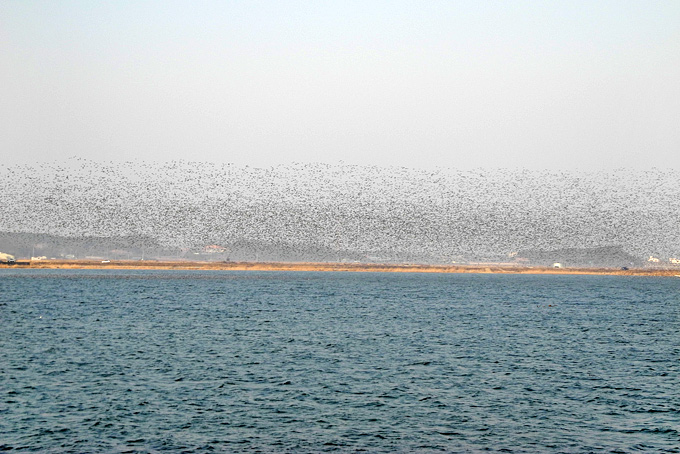
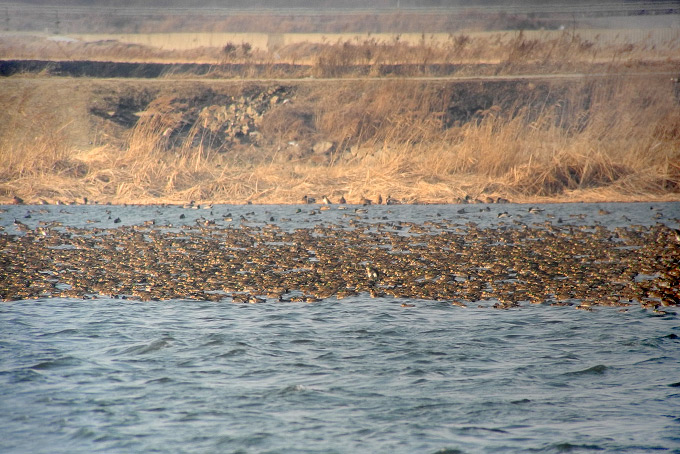

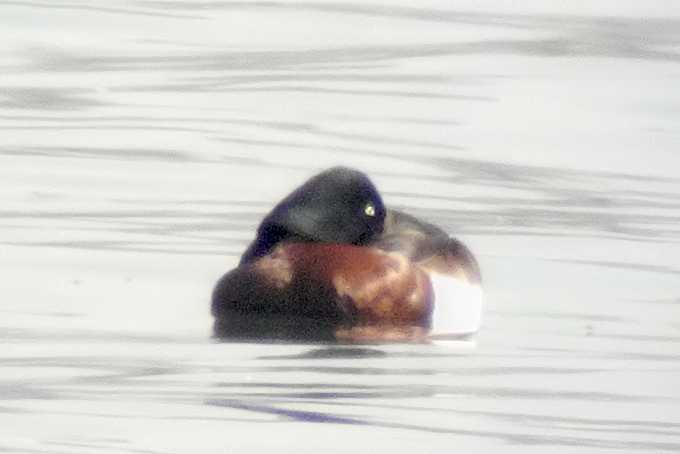

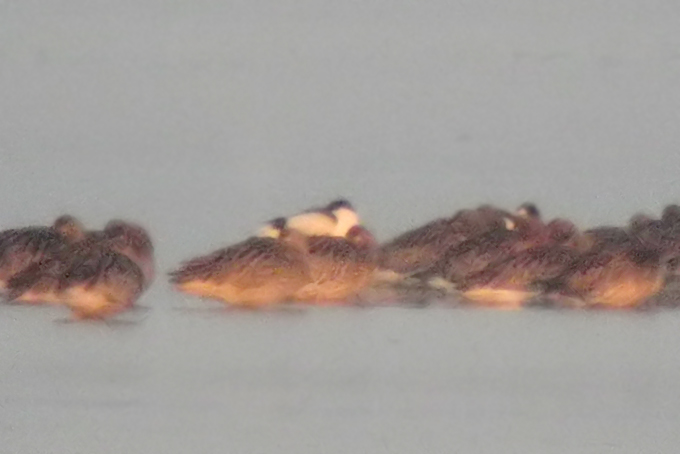
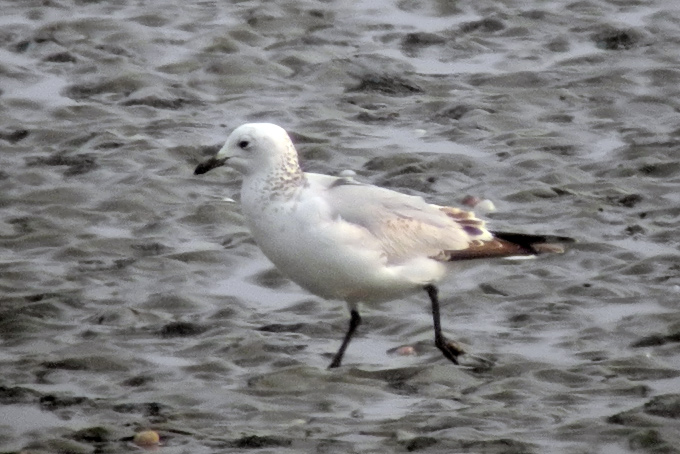
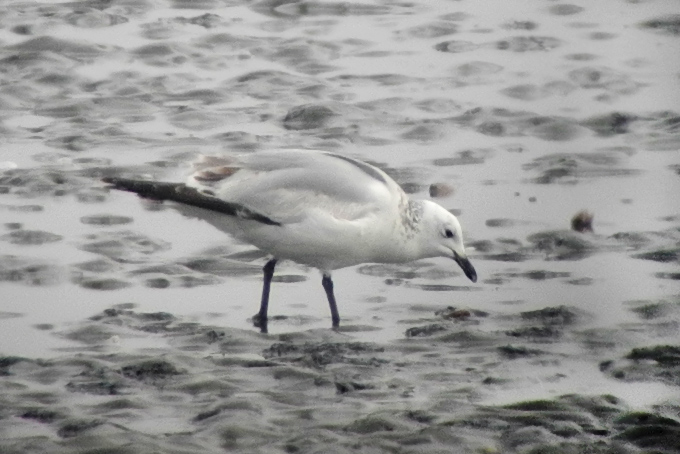
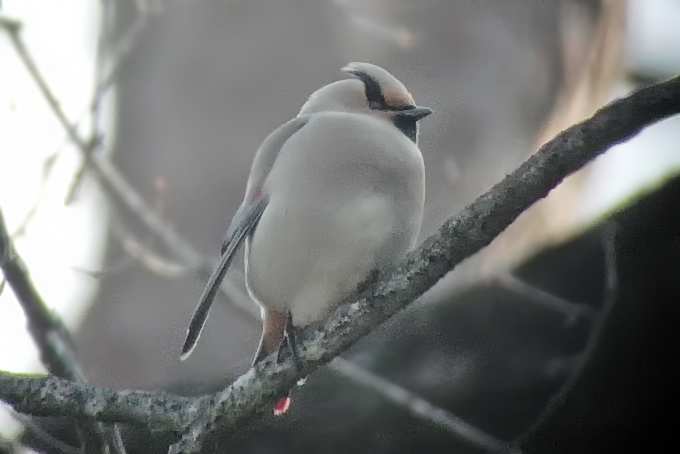
Mokpo, February 17
In the morning with light rain the stream between Samhyang and Yeongsan bridge was populated with 100 to 150 Black-headed Gull - like in the last two weeks, but today also 2 Black-tailed Gull were seen, one with only a small oil stain while the second one massively oiled - one wonders if these birds came from Yosu where last week an accident with oil-spill had occurred. Also on the stream 9 Little Egret, 7 Mallard, 2 Eastern-Spot-billed Duck and 1 Gadwall.
On the open water at the mouth of the stream c. 150 Great Crested Grebe and 2 Little Grebe were seen and very distant close to the barrage construction area at least 300 more unidentified gulls and several cormorants were noticed.
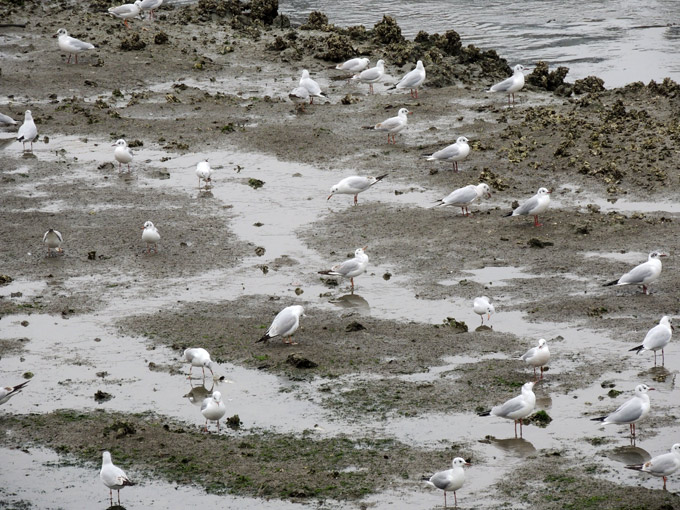
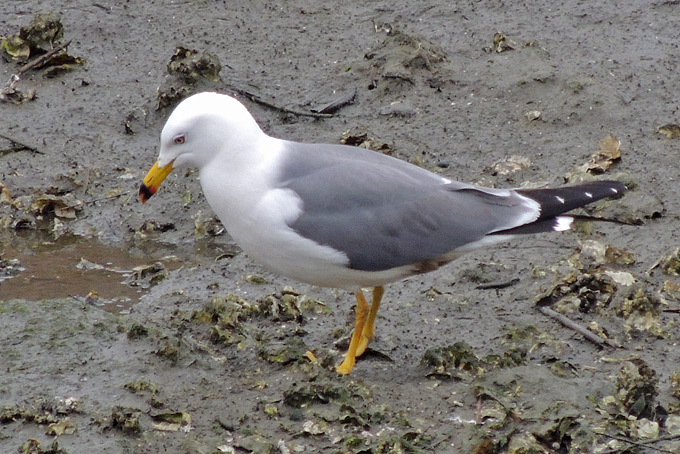
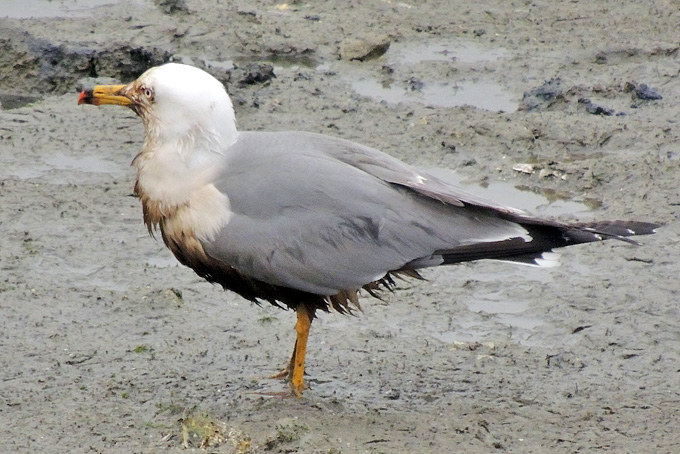
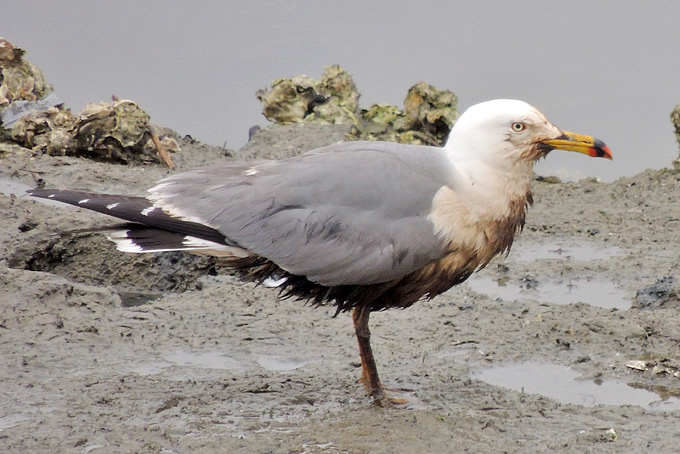
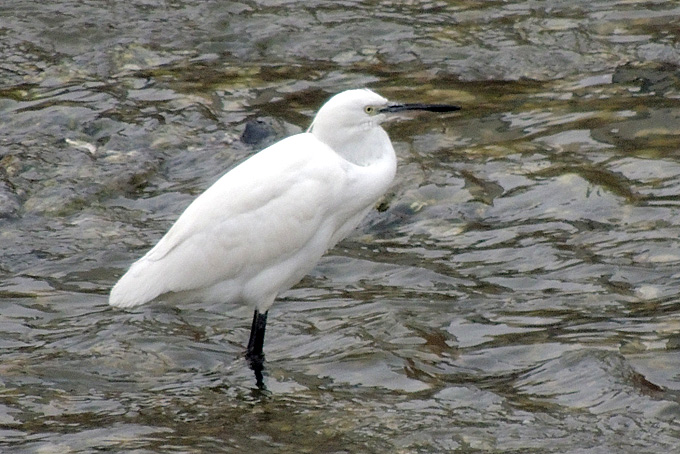
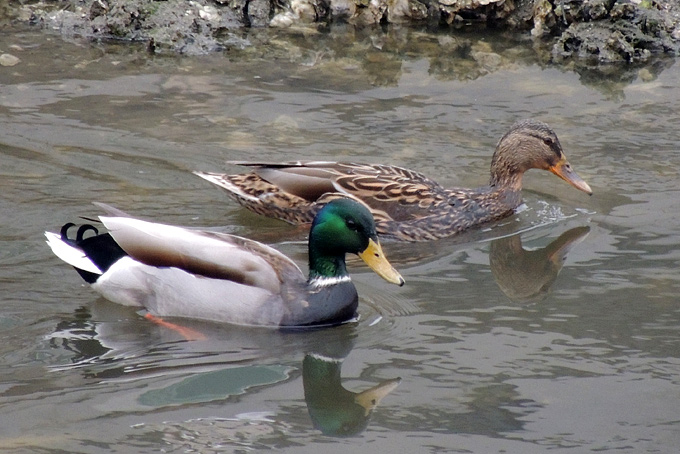
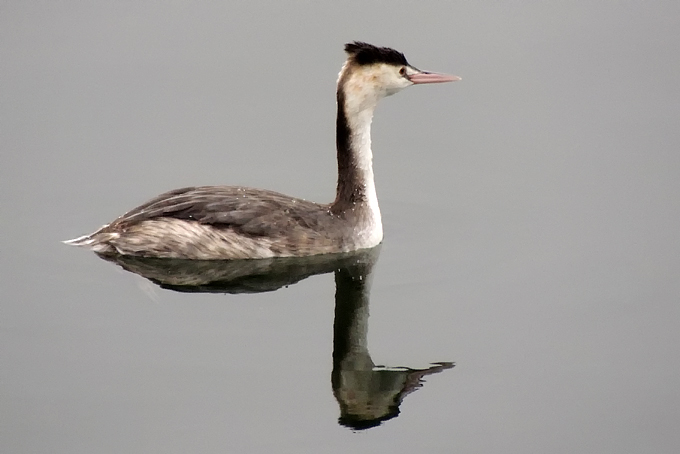
Junam Reservoir, February 16
Sunday afternoon at Junam was mostly clear-skied and quiet. It was a perfect day to be outside for a walk. We avoided the main entrance to the lake. In the surrounding rice fields, there were groups of Taiga Bean Goose, Greater White-fronted Goose, and a few Northern Lapwing. We sat and watched the lapwings feed and found Brambling, Rustic Bunting, and Yellow-throated Bunting in and out of nearby trees and bushes. There were a good number of thrushes in flight and perched in trees. These were mostly Dusky Thrush, some Naumann’s Thrush, and a few Pale Thrush. We saw Buff-bellied Pipit, lugens White Wagtail, a couple Bull-headed Shrike, many Oriental Turtledove, White-cheeked Starling and Eastern Great Tit. Woodpeckers observed and heard include Greater Spotted Woodpecker, Grey-headed Woodpecker, and Japanese Pygmy Woodpecker. Across the lake we found White-naped Crane but on the lake there seemed to be relatively few birds. We observed several Mongolian Gull, Black-headed Gull, a few Eurasian Spoonbill, and we shared great views of an adult White-tailed Eagle circling overhead. We were most enamored with about five Japanese Waxwing sat perched at tree top. A passing birder stopped by and we all shared a moment just admiring how perfectly beautiful these birds are.
Gangneung, February 15
Gangneung and Donghae both have had significant snowfalls of over a metre in the past week or so, and Gyeongpo Lake was almost entirely frozen.
On the last patch of running water, nice views of Korea's first confirmed Lesser Scaup (found a day earlier by Dr Moores and Co). At first difficult to differentiate, gradually its defining characteristics became more obvious- the velvet sheen to the dark head, the slightly smaller size, the defined patterning on the upperparts, the slightly scruffy look, the relatively smaller peaked head with barely discernible crest. like the suspected female of the species at Chungju last month, this one was also pugnacious, lunging at other ducks or trying to grab their food. Such aggressiveness could well be a consistent feature.
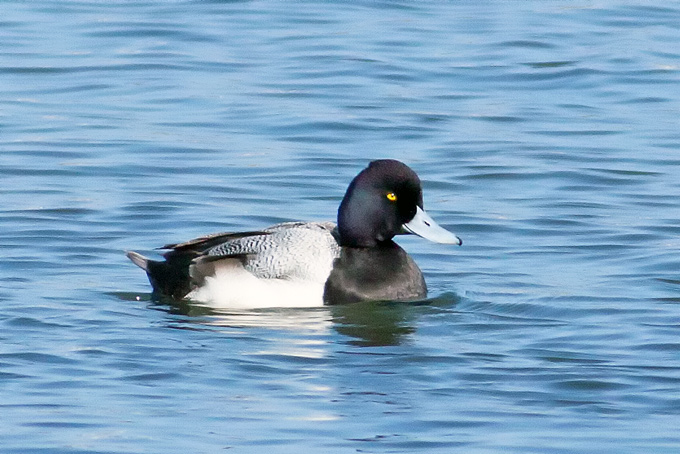
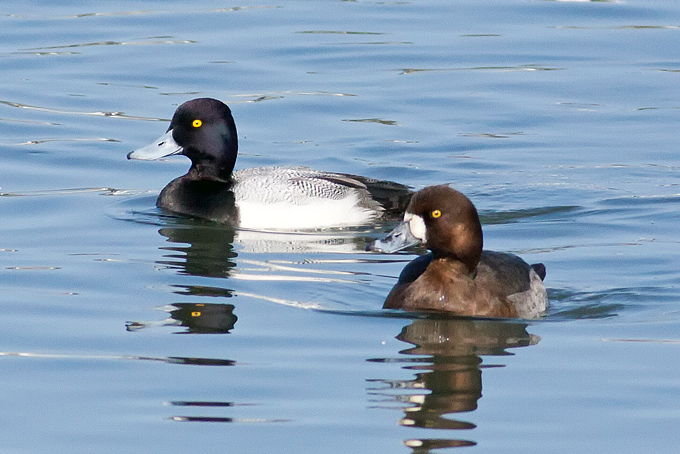
As well as numbers of Goldeneye and e.g. 33 Smew, it contrasted well with the many drake Greater Scaup, all of which showed a vibrant green tint to their larger, more rounded heads, with prominent forehead bulge and brighter blue bills. Also at these close quarters, the constant grating murmur of the females could be heard.
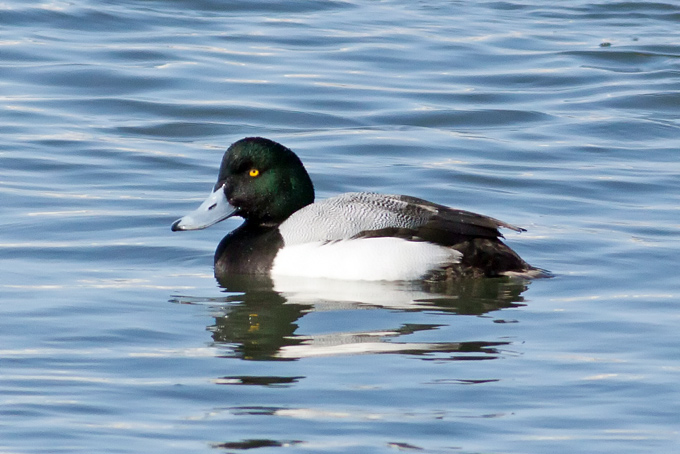
Gangneung, February 14
Although a much fuller report will be published later, the following is intended as a quick first-hand account of the discovery of the ROK’s first confirmed Lesser Scaup Aythya affinis.
On February 14th, following heavy snow along the east coast and under still-overcast skies, our group (comprised of 13 highly experienced birders) visited Gyeongpo Lake in Gangneung to see if the recent harsh weather might have resulted in some weather-driven displacement. Soon after arrival, several in the group checked through the flock of duck on the small remaining area of open water. Aleksi Lehikoinen was the first to pick up an odd-looking aythya, which appeared at long range to be more heavily vermiculated on the upperparts than the other scaup. With Dr. Hannu Huhtinen, he strongly suspected that the bird was a Lesser Scaup. They alerted others in the group, who also noted several other features in support of their proposed identification (including slightly smaller size; a slightly tufted rear to the head; a more delicate bill etc). After 30 minutes or so, the bird started to preen and showed its upperwing clearly (captured in the image below by NM) helping to rule out hybrid origin and to confirm the identification. Adequately documented with images, Lesser Scaup will therefore be added to Category One of the Birds Korea Checklist during the next update. This is the second North American duck species to be added to the national checklist this winter (with Bufflead Bucephala albeola also first-found in the winter of 2012 / 2013).

Seogwipo, Jeju Island, February 14
While on a bird-walk through the coniferous hills near town, I spotted a single Common Redpoll mixed in with about two dozen Eurasian Siskin – a noteworthy record for Jeju.
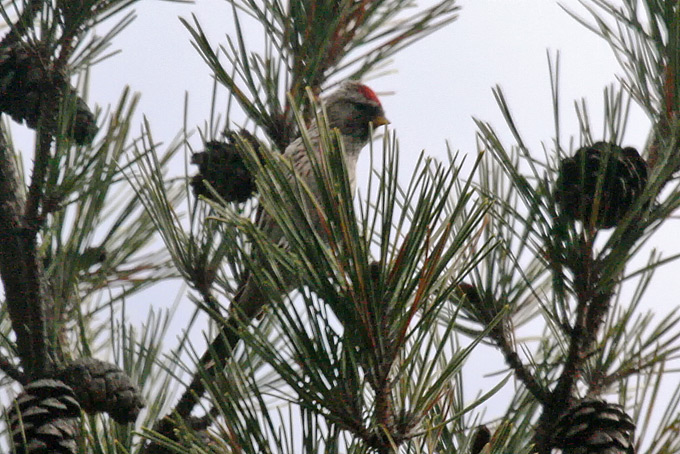
Donghae, February 11
At Odael beach today an assortment of gulls provided some amusement. Several were seen eating fallen snow (a useful source of freshwater) including one seen plucking snowflakes out the air as it roosted.
- Black-tailed Gull Larus crassirostris.
- Common Gull Larus canus.
- Glaucous Gull Larus hyperboreus. One apparent pallidissimus.
- American Herring Gull Larus smithsonianus. One possible individual showed a combination of features indicative of this taxon, including pale ash-grey mantle, clear pale eye with orange-red orbital ring, head-streaking extending down to breast-sides, darker smudge around the eye, flesh-coloured legs, deep-chested structure, and heavy, longish bill with orangey gonys spot not reaching to upper mandible edge.
- Vega Gull Larus vegae. The 60 or so individuals present were mostly typical vegae, with e.g. evenly pink legs, shortish bill with obvious gonydeal angle, dark brown eyes ( two or three only with pale iris), steep forehead giving vaguely round-headed appearance, and heavy blotching down nape. One untypical individual however (photographed below) showed a paler saddle; neater, more attenuated structure, bluish-grey legs and bill and very little white at the primary tips.
- Slaty-backed Gull Larus schistisagus.
- Taimyr Gull Larus heuglini taimyrensis. Six or seven present.
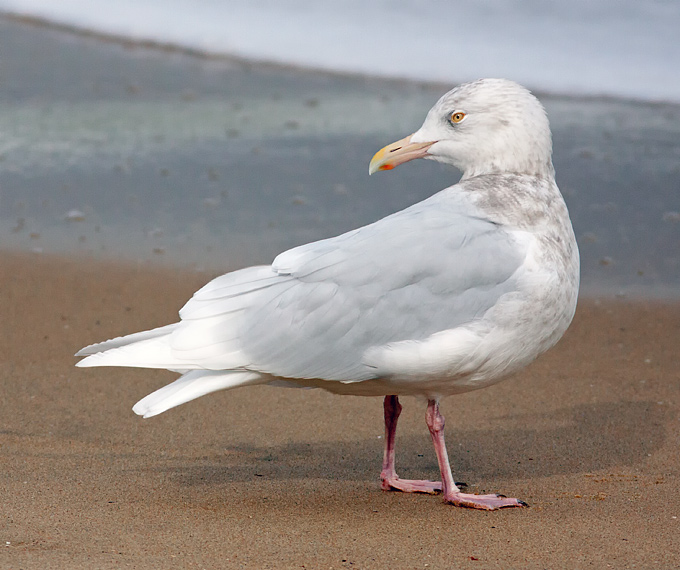
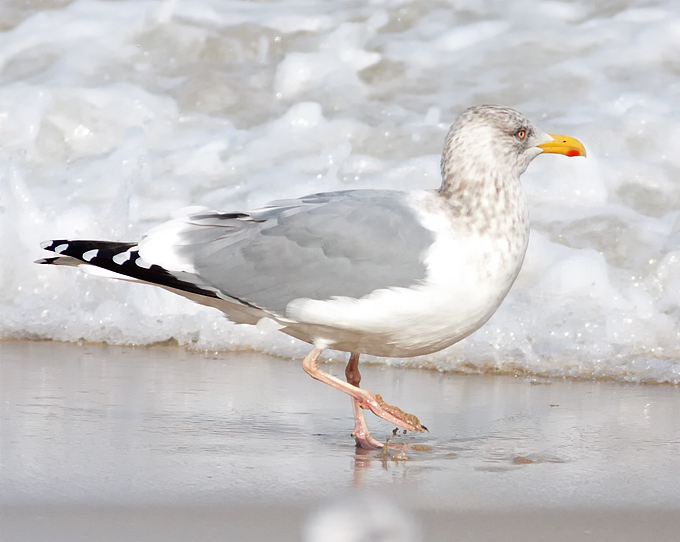
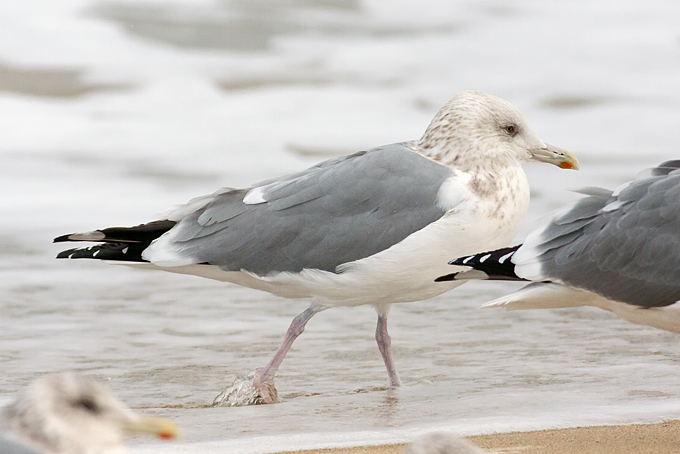
Mokpo Namhang Urban Wetland, February 10
The Mokpo Namhang Urban Wetland at present is mostly populated by ducks, but there had been significant change to previous years. With last year’s start of several construction activities the habitats have seen some changes which influence directly species staying on the site. Most numerous today were Eastern Spot-billed Duck with c. 350 while Mallard and Eurasian Wigeon in previous years had max-counts of over 300, today only less than 30 of each were seen. Also Eurasian Teal ‘s number has declined dramatically from former c. 900 down to c. 150 this winter. The removal of the former reed-bed in in the area (P4) (if more information on the four habitat areas P1-P4 is needed, please refer to the habitat page of the Mokpo Namhang Urban Wetland) had taken away the important shelter for Northern Shoveler so that only 7 were seen today, less than 10% of former max counts. The reed-bed was also used by over 50 Black-crowned Night Heron which of course haven’t been on the site this winter. Several platforms on the natural tidal area (P1) were used by ducks and c. 30 Great Cormorants as roosting place. A flock of c. 300 Black-headed Gull and about 40 Gadwall were seen. The lagoons (P2 and P3) didn’t have many birds. In P2 a few Grey Heron and ducks (Eurasian teal and Eastern Spot-billed Duck) stayed in very shallow water while in P3 a flock of c. 60 Vega Gull and about as many Common Shelduck (also 18 in P4) were the only ones seen. In the adjacent areas with grass and trees small numbers of White Wagtail, Grey-capped Greenfinch and Olive-backed Pipit were present. Two dead Eurasian Magpie were found under some trees, one apparently dead for some time and one very recent.



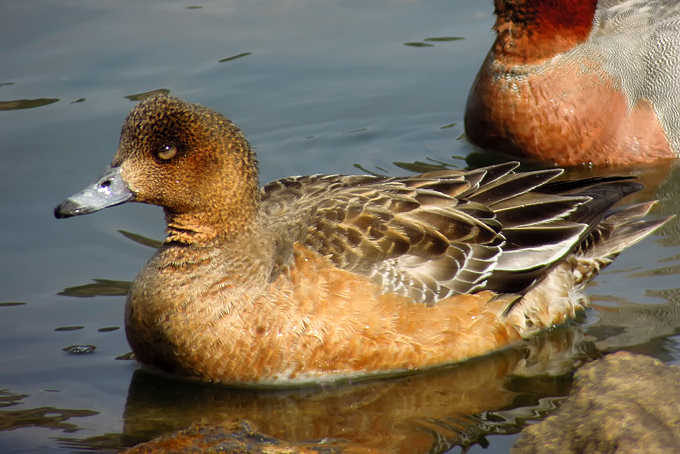













Ayajin Port, February 4
Predictably, development has come to this picturesque and sunny port, and they have built a park with railings over an area of rocks formerly used by the birds to feed. A look at the harbour and neighbouring beaches found the following:
- Brant Goose Branta bernicla. Three in the harbour. There used to be more here in winter but they have concreted over the rocks they used to feed on.
- Eurasian Wigeon Anas penelope. 17 feeding on seaweed in the shallows and rock pools.
- Mallard Anas platyrhynchos. Ten or so. Always unusual to see them in the sea rather than on freshwater.
- Eastern Spot-billed Duck Anas zonorhyncha. Several species of anatidae typically associated with inland freshwater seem to be distributed in marine areas the length of the east coast.
- Common Pochard Aythya ferina. Two in the harbour.
- Greater Scaup Aythya marila. Five or six diving in the harbour.
- Harlequin Duck Histrionicus histrionicus. Two off the north beach.
- Red-breasted Merganser Mergus serrator.
- Red-necked Grebe Podiceps grisegena.
- Black-necked Grebe Podiceps nigricollis. Four.
- Temminck's Cormorant Phalacrocorax capillatus.
- Sanderling Calidris alba. Ten or so along the south beach.
- Black-legged Kittiwake Rissa tridactyla. Four or five in the port.
- Black-tailed Gull Larus crassirostris.
- Common Gull Larus canus. Two or three present.
- Glaucous-winged Gull Larus glaucescens. One in the port.
- Glaucous Gull Larus hyperboreus.
- American Herring Gull Larus smithsonianus. One potential sighting under consideration. One or two have been reported here since January 22nd at least.
- Vega Gull Larus vegae. There seems to be a huge amount of individual variation within this species in terms of build, streaking, bill size, eye and leg colour, and overall structure. No two gulls look the same!
- Caspian Gull Larus cachinnans. One or two possible individuals showed features of this type, including long flesh-colored legs, mostly white head with gradually sloping forehead, longish bill lacking obvious gonys angle, and upright stance.
- Slaty-backed Gull Larus schistisagus.
- Taimyr Gull Larus heuglini taimyrensis. Up to ten on the south beach. Once again, a lot of variation within this group- some quite powerfully built, others shorter and smaller.
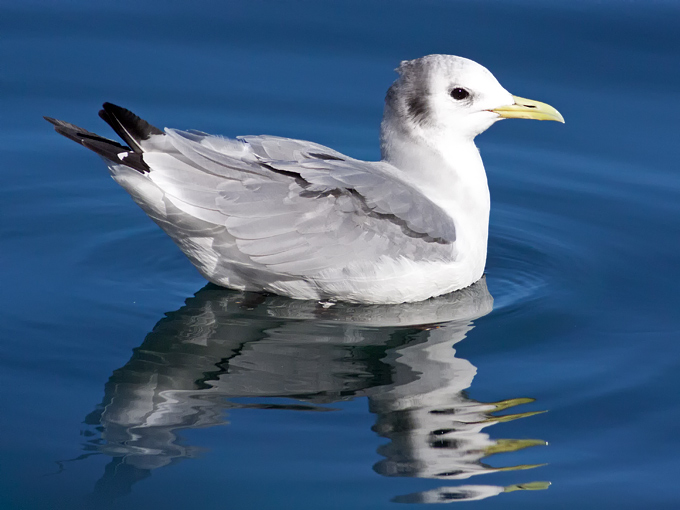
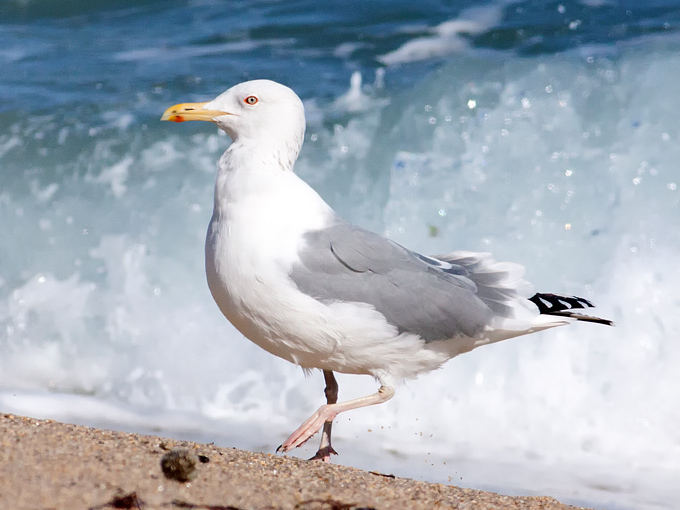
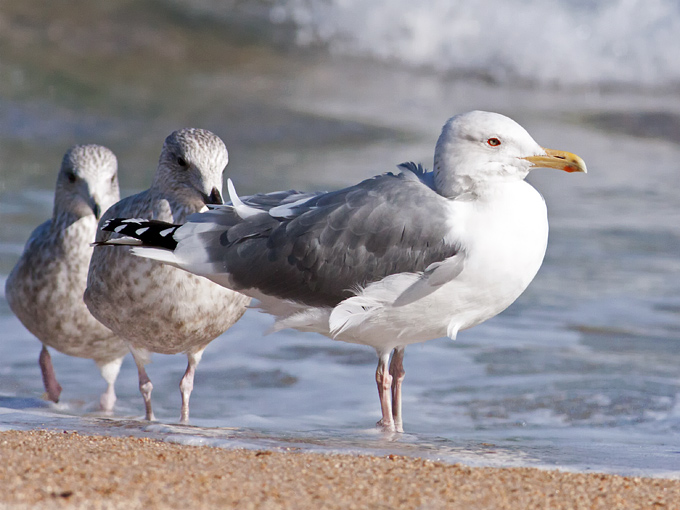
Songdo in winter
When does winter start in Songdo? For me, it is when the Great Cormorants disappear. This year, at least 200 were lined up on the islands and mudflats on Dec 1st. Two weeks later all had gone. I don’t think they go far. A colleague recently reported 300 flying along the Han river in Seoul. But in mid-winter, Songdo is cormorant-free. Waterfowl and shorebird numbers seem quite stable throughout the winter. Here are my counts.
- Bean Goose (35 on 2 Feb)
- Common Shelduck (1,000 birds wintering, numbers very steady and many more than last winter)
- Ruddy Shelduck (210 at Namdong Reservoir on 31 Jan)
- Gadwall (20)
- Falcated Duck (2 pairs, Namdong Reservoir on 11 January)
- Mallard (Perhaps 800 in the area in January, many more than last winter)
- Eastern Spot-billed Duck (500 in mid-December, but numbers lower subsequently)
- Northern Shoveler (500)
- Northern Pintail (100)
- Eurasian Teal (300, almost exclusively on Namdong Reservoir)
- Common Pochard (500)
- Tufted Duck (Up to 10)
- Greater Scaup (15)
- Common Goldeneye (50)
- Smew (2)
- Common Merganser (Up to 30)
- Red-breasted Merganser (10)
- Little Grebe (3)
- Great Crested Grebe (1 wpl on 2 Feb, I think my first for Songdo)
- Grey Heron (up to 18)
- Common Moorhen (Unusually, 2 up to 11 Jan, but not since)
- Eurasian Coot (7)
- Eastern Oystercatcher (10, up to 15 Dec, gone now I think. Last year Dunlin and Grey Plover also wintered but this year I have not seen any)
- Eurasian Curlew (the only wintering shorebird, with up to 700 birds)
Yesterday, 2 February, while visiting Namdong Reservoir, complete with AI Warning Signs (the signs were put up by Ministry of Agriculture around the reservoir, I wasn’t personally carrying AI warning signs.
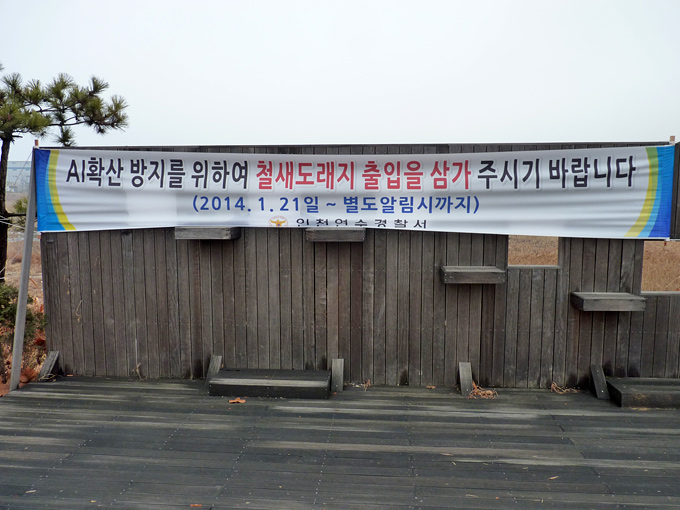
I looked up at the bare trees on the island to see 4 Great Cormorants, looking very handsome in their white-faced breeding dress, perched there. So maybe spring is coming ! However, when I looked up again they had gone, so perhaps they don’t really think it is spring at all …..





